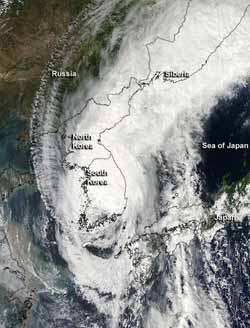NASA sees powerful Typhoon Sanba make landfall

NASA's Aqua satellite passed over Tropical Storm Sanba on Sept. 17 at 0430 UTC and the MODIS instrument captured this visible image of the storm when it was over South and North Korea. Some of Sanba's clouds extended north over eastern Siberia.<br><br>Credit: NASA Goddard MODIS Rapid Response Team<br>
Sanba downed trees, and caused power outages, canceled flights and canceled ferries. NASA's Aqua satellite captured a visible image of Sanba on Sept. 17 after it made landfall and observed the large extent of its cloud cover from South Korea to eastern Siberia.
NASA's Aqua satellite passed over Tropical Storm Sanba on Sept. 17 at 0430 UTC (12:30 a.m. EDT/1:30 p.m. local time Seoul, South Korea) and the Moderate Resolution Imaging Spectroradiometer (MODIS) instrument captured this visible image of the storm when it was over South and North Korea. The image revealed that some of Sanba's clouds extended north over northeastern North Korea and eastern Siberia.
According to the Associated Press, Sanba caused about 67,000 homes to lose power in southern Japan, and over 26,000 outages in South Korea. At least one death was reported.
At 0900 UTC (5 a.m. EDT) on Sept. 17, Sanba had maximum sustained winds near 45 knots (52 mph/83 kmh). It was located about 10 nautical miles northwest of Taegu, South Korea, near 37.2 North and 128.9 East. Since making landfall earlier in the day the storm has sped up and is moving to the north-northeast at 20 knots (23 mph/37 kmh). Surface observations from Taegu at that time indicated maximum sustained winds near 24 knots (27.6 mph/44.4 kmh) with gusts to 40 knots (46 mph/74 kmh).
Sanba is expected to experience some big changes over the next day. It is tracking over the rough terrain of the Taebaek Mountain range and is transitioning into an extra-tropical storm. That means that the core of the system will change from warm to cold.
The Joint Typhoon Warning Center expects Sanba to become a cold core low after its remnants emerge back in the Sea of Japan later today, Sept. 17, if it doesn't dissipate over land.
Media Contact
More Information:
http://www.nasa.govAll latest news from the category: Earth Sciences
Earth Sciences (also referred to as Geosciences), which deals with basic issues surrounding our planet, plays a vital role in the area of energy and raw materials supply.
Earth Sciences comprises subjects such as geology, geography, geological informatics, paleontology, mineralogy, petrography, crystallography, geophysics, geodesy, glaciology, cartography, photogrammetry, meteorology and seismology, early-warning systems, earthquake research and polar research.
Newest articles

Superradiant atoms could push the boundaries of how precisely time can be measured
Superradiant atoms can help us measure time more precisely than ever. In a new study, researchers from the University of Copenhagen present a new method for measuring the time interval,…

Ion thermoelectric conversion devices for near room temperature
The electrode sheet of the thermoelectric device consists of ionic hydrogel, which is sandwiched between the electrodes to form, and the Prussian blue on the electrode undergoes a redox reaction…

Zap Energy achieves 37-million-degree temperatures in a compact device
New publication reports record electron temperatures for a small-scale, sheared-flow-stabilized Z-pinch fusion device. In the nine decades since humans first produced fusion reactions, only a few fusion technologies have demonstrated…





















